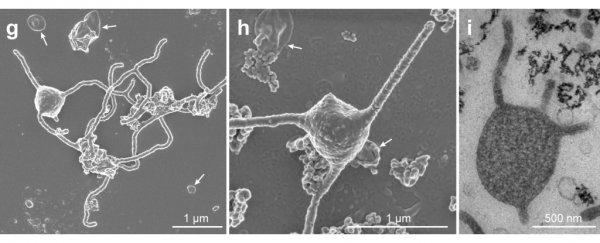When scientists ran DNA analysis on a sediment core taken from the floor of the Arctic ocean back in 2010, they found something surprising. A previously unknown organism belonging to the strange domain of microbes called Archaea appeared to have genomic characteristics associated with a totally different domain - Eukaryota.
They named their discovery Lokiarchaeota, after the Loki's Castle hydrothermal vent near Greenland where it was found; but doubt shadowed the finding. Could the sample have been contaminated by something else in the core?
Now, thanks to the work of Japanese scientists, those doubts can be put to rest. For the first time, they have isolated Lokiarchaeota, and grown it in a lab.
That means, for the first time, researchers can closely study and interact with living Lokiarchaeota, which could help us to find our very first ancestors on this incredible blue planet. Their research has been published on preprint server bioRxiv, and awaits peer review.
The tree of life, at its base, is divided into three domains. One of those is occupied by bacteria - single-celled microbes that don't have a nucleus or membrane-bound organelles, and get around by waving hair-like structures called flagella. Another is eukaryotes, organisms whose cells have nuclei and membranes. That domain includes us humans, animals, plants, and algae.
And then there are archaea. These are a lot like bacteria, in that they lack nuclei and membrane-bound organelles, and get around using flagella. But there are a few key differences. They divide differently. Their cell walls are made of slightly different stuff. And their RNA is different enough to separate them on the phylogenetic tree.
But then along came Lokiarchaeota - followed by other archaea specimens that had eukaryotic characteristics. These were named Thorarchaeota, Odinarchaeota and Heimdallarchaeota (to follow the same naming convention).
Collectively, they are called the Asgard archaea, and some scientists think they could be the origin of eukaryotic life - perhaps after an Asgard-like archaeon swallowed up a bacterium.
But it's hard to tell without studying the organisms in isolated detail. This is where the Japanese scientists come in. They retrieved a sediment core from the seabed in the Nankai Trough, 2,533 metres (8,310 feet) below sea level, in 2006.
This was before anyone knew about Asgard archaea. Only later, an RNA analysis of their rich sample revealed the presence of a Lokiarchaeota-like organism.
When the team started their work, they didn't know this yet. They carefully cultivated their samples for five years, in a methane-fed continuous-flow bioreactor system designed to mimic the conditions of a deep-sea methane vent. Very slowly, the microbes multiplied.
The next step was to place samples from the bioreactor in glass tubes with nutrients to keep them fed and growing. There they sat for another year, finally starting to develop a very faint population of Lokiarchaeota.
Then, the team invested even more time into isolating, cultivating and growing this slow-dividing population. Common bacteiral populations usually take about half an hour to double. Lokiarchaeota took 20 days.
"Repeated subcultures gradually enriched the archaeon with extremely slow growth rate and low cell yield," the researchers wrote in their paper.
"The culture consistently had 30-60 days of lag phase and required over 3 months to reach full growth [..] Variation of cultivation temperatures, and substrate combinations and concentrations did not significantly improve the lag phase, growth rate or cell yield."
In all, the experiment took 12 years. The researchers named their cultivated microbe Prometheoarchaeum syntrophicum - after Prometheus, the ancient Greek mythological Titan who was credited with creating humans out of clay.
They made several curious findings. The first is that Prometheoarchaeum would only grow in the presence of one or two other microbes, the archaeon Methanogenium and the bacterium Halodesulfovibrio. When Prometheoarchaeum breaks down amino acids into food, it produces hydrogen, which the other microbes eat.
If the hydrogen was allowed to hang around, the experiments revealed, this could further hinder Prometheoarchaeum's already slow growth, indicating the archaea has a symbiotic relationship with other microbes, in this case syntrophic - meaning the growth of one species or both depends on what the other eats.
Then, when the organism was examined under an electron microscope, it revealed an unusual shape for an archaeon - long tentacles sprouting from its body, within which its partner microbes nestled. When oxygen started increasing on Earth, the researchers hypothesised, this organism could have switched to a relationship with bacteria that used oxygen, increasing its chances of survival, and setting out on the path to eukaryotic life.
And indeed, DNA sequencing revealed the eukaryotic characteristics seen in other Asgard archaea.
Obviously more work needs to be done. Prometheoarchaeum might be quite different from the archaea of billions of years ago. And it's far from definitive proof that eukaryotes evolved from archaea.
The study is so far available ahead of peer-review, so it will be interesting to see what the scientific community makes of it, in time. But no matter what happens now, we're going to learn a heck of a lot from this work.
"This is a monumental paper that reflects a tremendous amount of work and perseverance," evolutionary microbiologist Thijs Ettema of Wageningen University, who wasn't associated with the paper, told Nature.
"It's a major step forward in understanding this important lineage."
The research is available on bioRxiv.
